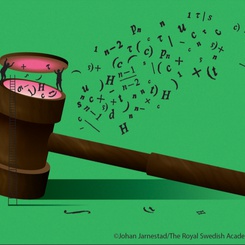This year, the Royal Swedish Academy of Sciences has granted the Sveriges Riksbank Prize in Economic Sciences in Memory of Alfred Nobel to professors David Card (University of California, Berkeley), Joshua D. Angrist (MIT, Cambridge) and Guido W. Imbens (Stanford University). They have been granted the award for a path-breaking strand of research in empirical economics, with emphasis on causality checks. Their main field of application is labor economics, including immigration and education issues. We all have a thought for professor Alan Krueger (Princeton), who passed away in 2019, and who was a major contributor to the field and a friend and a co-author of the laureates.
Economics is a consistent field of research – there is a strong theoretical base on which economists build their analyses. Theory guides collection of large datasets, and econometricians put theories and assumptions to the hard test of reality. However, the traditional econometric tests were often subject to criticism with respect to their weak ability to reveal causality. If two events occur systematically at the same time, how to infer from such an observed regularity that the first is the cause of the second, or the second is the cause of the former, or that a hidden variable change is driving both the observed ones?
Economists who perform lab or field (controlled trial) experiments have addressed this issue in a straightforward way, inspired by statistical research in medical science, using the difference-in-difference method. For instance, when testing the efficacy of a new drug, laboratories assign patients at random to two groups, apply the “treatment” to one group while the other receives a placebo, and check whether there is a difference in the response to a disease between the control and treatment group. The Nobel prize in economics to Esther Duflo and Abhijit Banerjee in 2019 rewarded their research on controlled trial experiments, mainly in the field of development economics. Unfortunately, field experiments involve considerable logistics and substantial funding needs that might limit their general use, not to mention some ethical questions (can we exclude someone from a policy that improves welfare?).
An alternative is to take advantage of exogenous external change that affects only a subset of a given population, a “natural” experiment. Some subjects (could be people, firms, territorial units, etc.) will find themselves de facto in the treatment group, the other in the control group, depending on luck. This creates conditions to apply the logic of difference in difference to large scale studies.
Results from one such “natural experiment” were published by David Card and Alan Krueger in 1994 in the American Economic Review. They measured average employment per shop in the fast food industry in New Jersey and Pennsylvania, two neighboring states. In 1992, New Jersey raised its minimum wage from $4.25 to $5.05 an hour, while Pennsylvania kept it unchanged. After the regulatory change, the average employment went up in New Jersey, while it fell in Pennsylvania. Many have interpreted this result as refutation of standard economy, which is not; it only suggests that the fast food sector might enjoy monopsony power with respect to the population of students for whom it is the only reliable employer. However, what we should celebrate is the implementation in economic research of methods that address the causality issue in a most rigorous way. Here the effect of the minimum wage raise can be clearly identified, as the influence of any unobserved variable would be neutralized by the comparison between the (almost) identical economic environment in the two states.
In another famous study in the Quarterly Journal of Economics in 1991, Angrist and Krueger exploit the “natural” variation induced by compulsory schooling regulation. In many US states, children begin school in August of the calendar year when they turn 6. They can leave school when they are 16. Thus, in the same cohort, there will be relatively young, and relatively older children, who all can legally stop school when they are 16. Thus children with a different birthday will have a different compulsory schooling time. This creates a natural experiment, where children are allocated at random to a “quarter of birth”, from one to four. Data reveals that, for a given age group, children born in the 4th quarter tend to go for longer education years (and have higher wage earnings). Because the quarter of birth can be related to schooling time, but not directly to wage earnings, it can be used as an instrument in a regression of wages on education years, even if important personal characteristics such as innate ability of family connections are not observed. This approach combines statistical power with parsimony.
This group of economists and econometricians - Card, Krueger, Angrist and Imbens - pushed to a high level of sophistication the techniques that, some of them combined with traditional econometrics, allow to determine causality when an external event entails an exogenous random allocation of individuals to groups relevant for the analysis. This goes to a new approach to instrumental variable regression (where the instrument is connected to the institutional shock), to regression discontinuity design. Reading the best-selling “Mostly Harmless Econometrics” by Angrist and Pischke will reveal to the reader the fundamentals of these new techniques. For sure, some theories cannot be tested in this way, since ultimately, one external or natural shock is needed to implement the analysis, and such natural events are scarce.
To sum up, the 2021 Nobel prize rewards many new results in labor and education economics, and, most importantly, for advancing economics as an experimental science, that can reveal causality, and not only correlation. These methods – lab, field and quasi-natural experiments - reinforce the scientific nature of economics, as they help test economic theories in the most efficient way.









